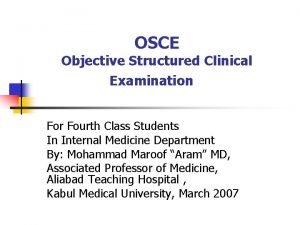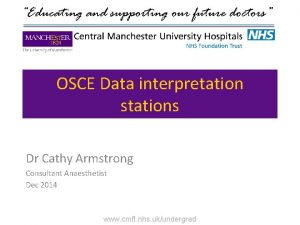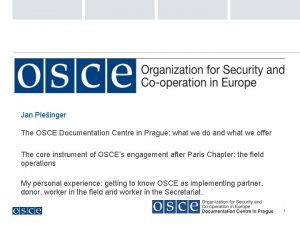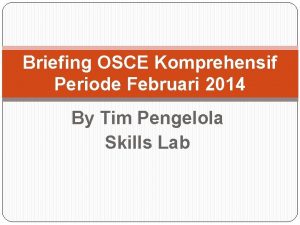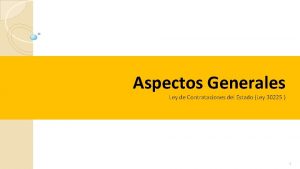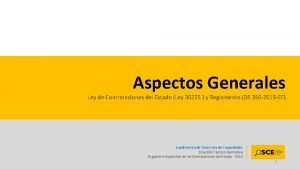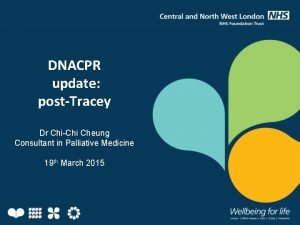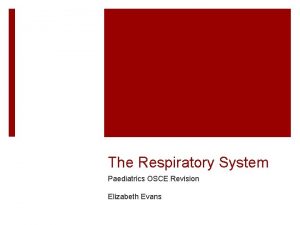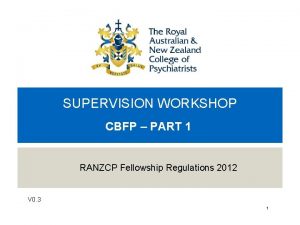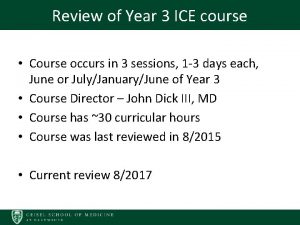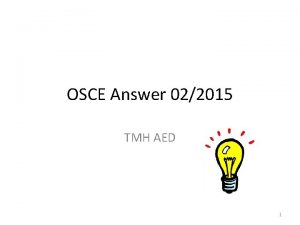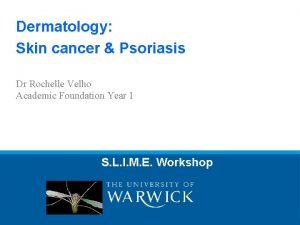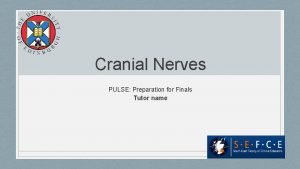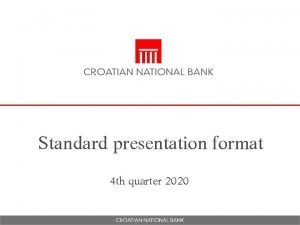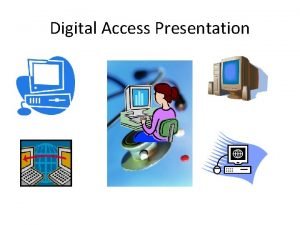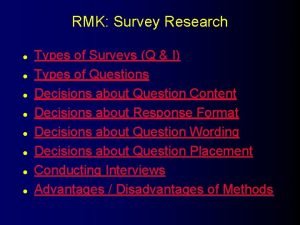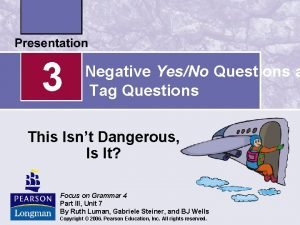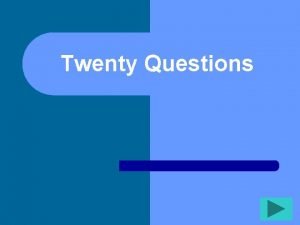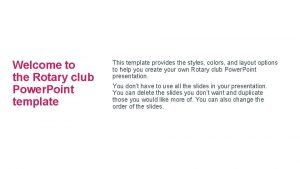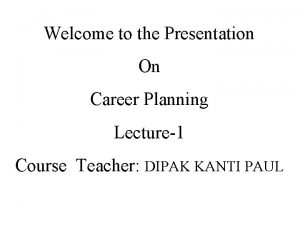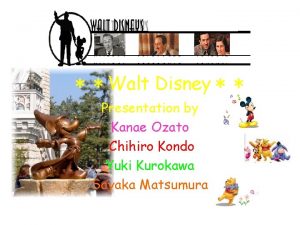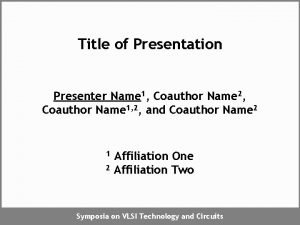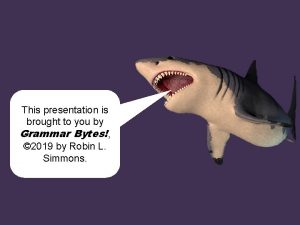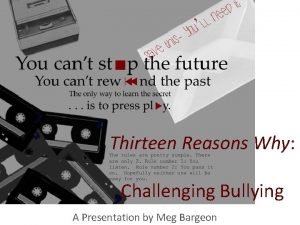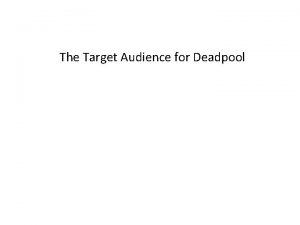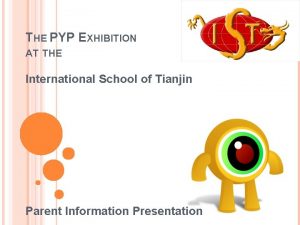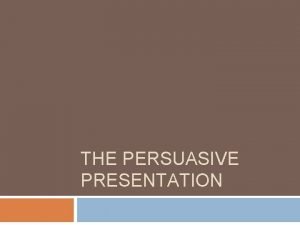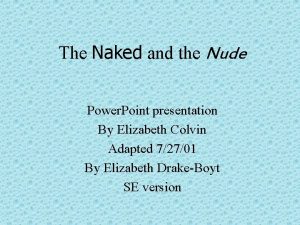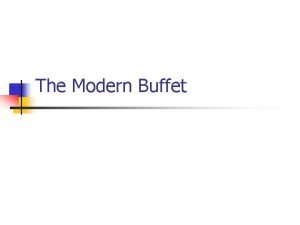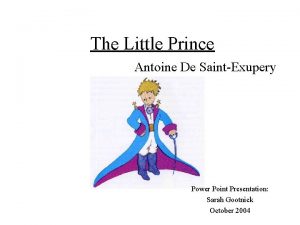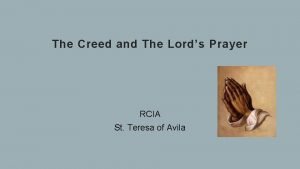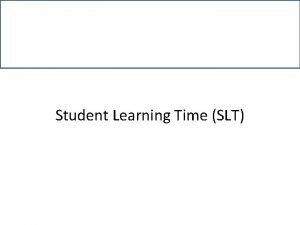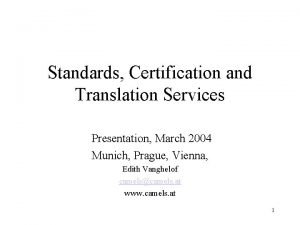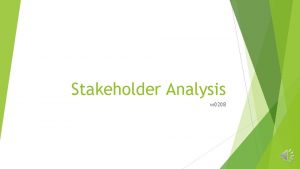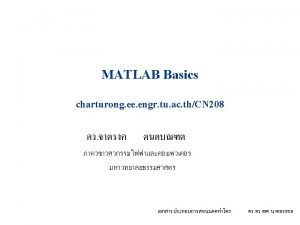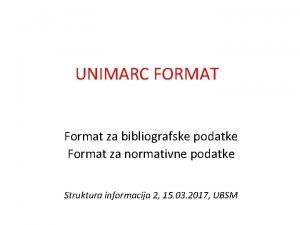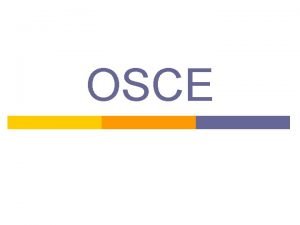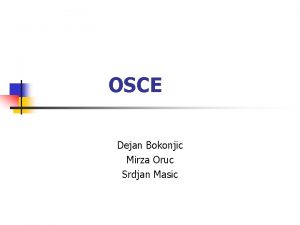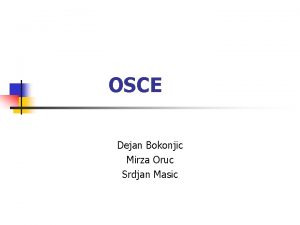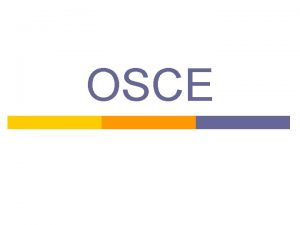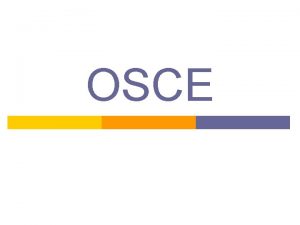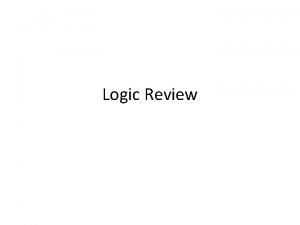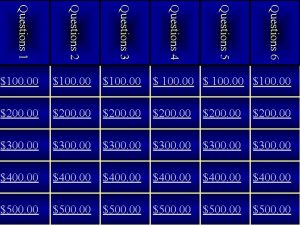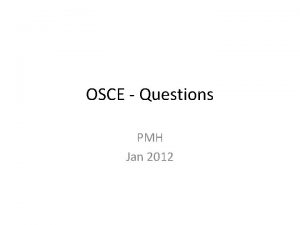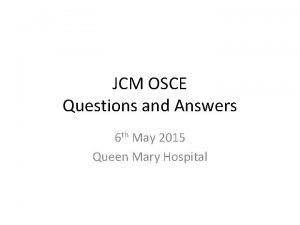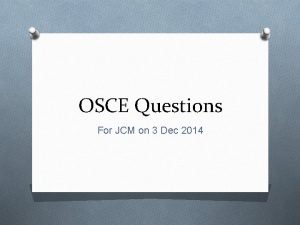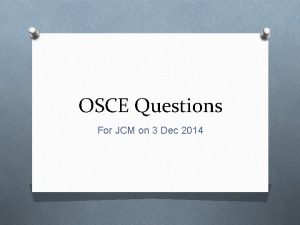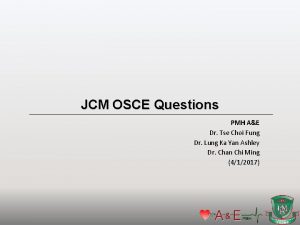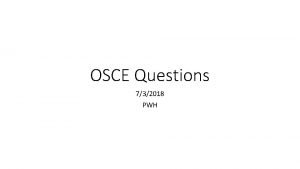OSCE Presentation RTSKH OSCE format 4 Questions 10














































































- Slides: 78

OSCE Presentation RTSKH

OSCE - format 4 Questions. 10 points each.

Case 1 30 year old lady Requested by a friend to binge drink in order to exchange for a loan 1 bottle of whisky, 1 bottle of champagne, and red wine Vomited multiple times Called 999 by 7 year old son In cubicle, too drunk and weak to provide history

Case 1 BP stable Pulse 103 E 3 V 3 M 5 Afebrile Alcohol smell Chest clear Abdomen soft and nontender An ECG was taken

Case 1 - ECG

Case 1 Q 1 Besides sinus tachycardia, list 4 ECG features seen. (2 marks)

Case 1 Q 1 Diffuse ST depression Diffuse T wave inversion Prominent U waves Long QU (apparent long QT)

Case 1 Q 2 A. What is the diagnosis? (1 mark) B. Name 4 blood tests you would consider to conduct as related to the above diagnosis. (2 marks)

Case 1 Q 2 A. -Hypokalemia (0. 5 mark) -Hypokalemic hypochloremic alkalosis (1 mark) B. -RFT (0. 5 mark each) -ABG -Serum chloride -Serum magnesium

Case 1 Q 3 Give your management to the patient. (2 marks)

Case 1 Q 3 Any 4 of the below, 0. 5 marks each R room, IV access, oxygen, cardiac monitor Consider intubation for decreased GCS and repeated vomiting K supplement IVF K (10 mmol K in 100 ml NS in 30 min, max via P line) Blood tests including alcohol / toxicology level – drugs will prolong QT ICU consultation Psychiatric consultation Refer MSW

Case 1 Q 4 While the patient is being monitored and was under treatment, she suddenly collapsed. Cardiac monitor rhythm strip showed:

Case 1 Q 4 A. What is the rhythm diagnosis and mechanism behind it? (1 mark) B. What is the specific treatment? (2 marks)

Case 1 Q 4 ►A -R on T leading to Torsade de Pointes ►B -Defibrillation ► -Magnesium sulfate 1 -2 g in 30 -60 seconds, can be repeated in 5 minutes

Case 2 A 42 years old lady complained of twisting injury to her left ankle after jumping from a rock about 1 meter from the ground during hiking Managed to walk immediately but called GFS later because of increasing pain No other injury complained Examination showed tenderness and swelling over the medial and anterior aspect of left ankle X-rays of her left ankle were taken

Case 2 Q 1

Case 2 Q 1 Describe the x-rays findings. (1 mark)

Case 2 Q 1 Tibial pilon fracture ( fracture of distal tibia with intra- articular involvement) Or Fracture of anterolateral tubercle of tibia

Case 2 Q 2 What is the significance of this fracture? (1 mark)

Case 2 Q 2 Syndesmosis injury or instability

Case 2 Q 3 Name 2 clinical tests you may want to perform? ( 2 marks)

Case 2 Q 3 Midcalf squeeze test (Hopkin’s test) • compression of tibia and fibula at midcalf level causes pain at syndesmosis External rotation stress test • pain over syndesmosis is elicited with external rotation/dorsiflexion of the foot with knee and hip flexed to 90 degrees

Case 3 Q 3

Case 2 Q 4 What other view of the left ankle you may order? ( 1 mark)

Case 2 Q 4 External rotation stress view Or Weight bearing mortise view

Case 2 Q 5 Radiography of what other region you may also want to take? ( 1 mark)

Case 2 Q 5 Whole left lower leg / whole left tibia and fibula

Case 2 Q 6

Case 2 Q 6 What is the name of this kind of fracture? (1 mark)

Case 2 Q 6 Maisonneuve fracture of left lower leg • Maisonneuve fracture is the combination of a spiral fracture of the proximal fibula and unstable ankle injury which could manifest radiographically by widening of the ankle joint due to distal tibiofibular syndesmosis and/or deltoid ligament disruption, or fracture of the medial malleolus.

Case 2 Q 7 CT scan of left lower leg was performed. Describe the CT findings. (1 mark)

Case 2 Q 7

Case 2 Q 7

Case 2 Q 7 Fracture of proximal fibula Fracture of anterolateral tubercle of tibia Fracture of posterior tubercle of tibia

Case 2 Q 8 Name the 2 important ligaments that were injured according to the CT findings. ( 2 marks)

Case 2 Q 8 Anterior inferior tibiofibular ligament posterior inferior tibiofibular ligament / transverse tibiofibular ligament

Case 2 Q 8

Case 3 Male 84 Hx of HT Accidentally fell backward in HK Stadium, down 2 -3 steps of stairs On arrival, E 1 V 1 M 5, BP 134/84 mm. Hg P 86/min, RR 18/min, Sp. O 2 100% Pupils 4 mm equal sluggish response to light Large hematoma with wound over posterior scalp CT brain was performed

Case 3

Case 3

Case 3

Case 3 Q 1 Give 4 significant CT findings. (4 marks)

Case 3 Q 1 Any 4 of below: - Traumatic SAH - Traumatic SDH - Depressed skull fracture - Cerebral contusion - Intracranial foreign body - Pneumocephaly - Cerebral edema / mid-line shift - Extracranial soft tissue swelling

Case 3 Q 2 You decided for intubation. A. What precaution you have to consider while performing intubation? (1 mark) B. What is the critical value of monitoring parameter to prevent hyperventilation? (1 mark)

Case 3 Q 2 A. Endotracheal intubation with cervical in-line immobilization under rapid sequence induction B. Pa. CO 2 / ETCO 2 maintained ≥ 25 mm. Hg

Case 3 Q 3 Name 4 mode of bedside clinical investigations you may consider for this patient. (0. 5 marks x 4)

Case 3 Q 3 X-rays – trauma series: X-rays chest, cervical spines, pelvis USG – e. FAST ECG Blood tests – H’stix or blood glucose, CBP, LRFT, clotting profiles, ABG, X-match

Case 3 Q 4 What prophylactic measures you may consider for this patient? (2 marks)

Case 3 Q 4 Any 2 of below: - Prophylactic antibiotic - Prophylactic hypothermia - Prophylactic hyperosmolar therapy - Prophylactic anti-convulsant - Prophylactic transamin

Case 3 Q 4 Prophylactic antibiotics For skull base fracture? - Low incidence, not indicated - Journal of Clinical Neuroscience; Mar 2016, Vol. 25 For depressed skull fracture? - Open vs closed - Open : one single dose preoperatively For penetrating head injury? - no RCT, observational cohort only, presumptive antibiotic indicated, Journal of Trauma and Acute Care Surgery, volume 81(4), October 2016

Case 3 Q 4 § § § Prophylactic hypothermia – when and how Reduce tissue damage related to CNS trauma Reduce ICP – temporizing Prophylactic – apply before ICP elevation Therapeutic – apply after ICP raised Evidence: Level ll b – Early (<2. 5 hours after onset) and shortterm (<48 hours post injury) prophylactic hypothermia is not recommended to improve outcomes in patients with diffuse TBI Prophylactic hypothermia: may consider after 2. 5 hours post injury for at least 48 hours, 32 -35 C

Case 3 Q 4 Prophylactic hyperosmolar therapy (normal serum 287 m. Osmol/L) For increased ICP (maintain ICP <20 mm. Hg) Mannitol bolus (0. 25 -1 g/kg) Fast onset, no need for central line, requires foley Hypo. K, alkalosis, hyperglycemia, renal failure Hypertonic saline (2%-23% saline), bolus and continuous infusion Requires central line, beware of fluid overload Current trend: favors hypertonic saline COBI (COntinuous hyperosmolar therapy in traumatic Brain-Injured patients) trial

Case 3 Q 4 Prophylactic anticonvulsant - Prophylactic antiepileptics after severe head injury may be effective in reducing early seizures, but not associated with differences in occurrences of late seizures, death, or neurological disability Level II - Phenytoin recommended to decrease incidence of early posttraumatic seizures (within 7 days of injury), when overall benefit likely to outweigh complications associated with treatment; early posttraumatic seizures have not been associated with worse outcomes (BTF IIa)

Case 3 Q 4 Transamin / Tranexamic acid – anti-fibrinolytic - 1 g over 10 mins loading, then 1 g infusion over 8 hours - Tranexamic acid may reduce all-cause mortality and progressive intracranial hemorrhage in patients with acute traumatic brain injury (level II) - Tranexamic acid might reduce mortality in patients with traumatic brain injury BMJ 2011 Jul 1; 343

Case 4 A 50 years old gentleman went to play paragliding. When he was about to land, he lost his balance and sustained hyperplantarflexion injury to his right ankle then landed onto his left shoulder. He complained of severe pain over his right ankle and left shoulder. He was not able to walk as his right ankle was clearly deformed. He was able to move his left shoulder, although there was tenderness over his left acromioclavicular joint.

Case 4 Q 1 X-rays of his left ACJ was taken.

Case 4 Q 1

Case 4 Q 1 What is the diagnosis? (1 mark) What is the classification system to the above injury? (1 mark) What is the normal width of the ACJ in adults? (1 mark)

Case 4 Q 1 Left ACJ Type III injury Rockwood Classification of Acromioclavicular Joint Separation 1 -3 mm

Rockwood Classification of Acromioclavicular Joint Separation Type I sprain or partial tear of the AC ligaments ACJ tenderness, no deformity Coracoclavicular ligaments nontender II complete tear of the AC ligaments with no injury or partial injury of the CC ligaments Radiographs show partial elevation of the distal clavicle with no or minimal widening of the CC distance (11 -13 mm) III complete disruption of both the AC and CC ligaments IV occur with forceful shoulder trauma that causes disruption of the AC and CC ligaments, and displaces the distal clavicle into or through the trapezius V Sternoclavicular (SC) dislocations occur more often with Type IV injuries VI severe dislocations of the AC joint in which the distal clavicle is forced into the subacromial or subcoracoid position

Case 4 Q 2 Name 2 other views of the shoulder you may also want to order if fracture of the coracoid process is suspected. (2 marks)

Case 4 Q 2 Any 2 of below (0. 5 marks x 2) Zanca view of shoulder AP view of glenoid Axillary view of shoulder

Case 4 Q 2 Zanca view: AP with 10 - 15 degrees cephalic tilt

Case 4 Q 2

Case 4 Q 2 Axillary view demonstrating fracture of the coracoid process

Case 4 Q 3 X-rays of patient’s right ankle and foot were taken.

Case 4 Q 3

Case 4 Q 3

Case 4 Q 3 Describe the radiological findings. (1 marks)

Case 4 Q 3 Tri-malleolar fracture of right ankle Dislocation of ankle

Case 4 Q 4 You proposed performing closed reduction to his right ankle under procedural sedation, and propofol was the agent you had chosen. What is the normal dosage of propofol you will give? (1 mark) Name 2 parameters you would like to monitor during the procedure? (1 mark)

Case 4 Q 4 Dosage of Propofol for procedural sedation: 0. 5 - 1 mg /kg Blood pressure, end-tidal CO 2, oxygen saturation, conscious level (GCS/ sedation score – Ramsay sedation scale, Richmond agitation-sedation scale etc)

Case 4 Q 5 Under adequate sedation and correct technique, you tried to perform closed reduction of his right ankle for the patient. However the procedure was unsuccessful. What is the likely cause? (1 mark)

Case 4 Q 5 Entrapment or posterior dislocation of the fractured distal fibula fragment behind tibial incisura fibularis

Case 4 Q 5

Case 4 Q 6 What is the diagnosis with respect to the condition in his right ankle? (1 mark)

Case 4 Q 6 Bosworth fracture-dislocation

Thank you
 Rtskh
Rtskh Rtskh
Rtskh Pc hpc pmh
Pc hpc pmh Osce medical
Osce medical Conn’s syndrome
Conn’s syndrome Osce documentation centre in prague
Osce documentation centre in prague Rutherford morrison scar
Rutherford morrison scar Ospe sample stations
Ospe sample stations Osce komprehensif adalah
Osce komprehensif adalah Arbitraje ad hoc
Arbitraje ad hoc Osce
Osce Procedimiento de selección osce
Procedimiento de selección osce Dnacpr osce
Dnacpr osce Cornyebacteria
Cornyebacteria Ranzcp wba
Ranzcp wba Ice osce
Ice osce Question
Question Melanoma vs mole
Melanoma vs mole Cranial nerve osce
Cranial nerve osce Diameters of fetal head
Diameters of fetal head Leopold's maneuver
Leopold's maneuver Standard presentation format
Standard presentation format Presentation and demonstration
Presentation and demonstration Karangan sepandai pandai tupai melompat
Karangan sepandai pandai tupai melompat Internet access survey questions
Internet access survey questions Contingency questions/cascade format
Contingency questions/cascade format Testable questions format
Testable questions format Direct question
Direct question Example of factor-relating question
Example of factor-relating question Negative yes no question
Negative yes no question Texting games to play
Texting games to play In pairs or as a group discuss the questions
In pairs or as a group discuss the questions Yelp case study analysis
Yelp case study analysis Font sans serif
Font sans serif World university of bangladesh
World university of bangladesh Wirtinger presentation
Wirtinger presentation Wireless presentation tco
Wireless presentation tco Iso 9001:2015 awareness presentation ppt
Iso 9001:2015 awareness presentation ppt Brattle group
Brattle group Rotary international powerpoint template
Rotary international powerpoint template Career planning presentation
Career planning presentation Welcome to our presentation
Welcome to our presentation Welcome to india presentation
Welcome to india presentation Walt disney presentation
Walt disney presentation Vlsi ppt presentation
Vlsi ppt presentation Us bank developer portal
Us bank developer portal Transferable skills presentation
Transferable skills presentation Tok mark bands
Tok mark bands Fortinet
Fortinet Presentation by name
Presentation by name Presentation time management
Presentation time management This presentation is brought to you by
This presentation is brought to you by Pechakucha template
Pechakucha template 13 reasons why bullying
13 reasons why bullying Wolf of wall street secretary
Wolf of wall street secretary Deadpool slides
Deadpool slides Presentation of candidates for confirmation
Presentation of candidates for confirmation Pyp exhibition presentation ideas
Pyp exhibition presentation ideas Define persuasive presentation
Define persuasive presentation Brow presentation
Brow presentation Naked presentation
Naked presentation Modern buffet presentation
Modern buffet presentation Little prince powerpoint template
Little prince powerpoint template Presentation outline slide
Presentation outline slide First 100 days presentation
First 100 days presentation An effective multimedia presentation
An effective multimedia presentation Our father creed
Our father creed Rbmk reactor chernobyl
Rbmk reactor chernobyl What is a reference page in apa format
What is a reference page in apa format Cyber security board of directors presentation
Cyber security board of directors presentation Presentation description example
Presentation description example Copyright
Copyright Symbolic presentation
Symbolic presentation Slt presentation
Slt presentation Different stocks and sauces
Different stocks and sauces Certified presentation translation
Certified presentation translation Onion model of stakeholders
Onion model of stakeholders St logistic
St logistic Vad är kronolekt
Vad är kronolekt



